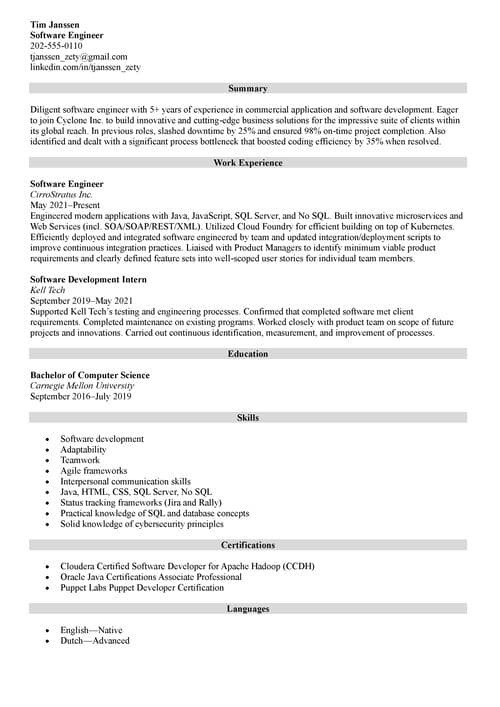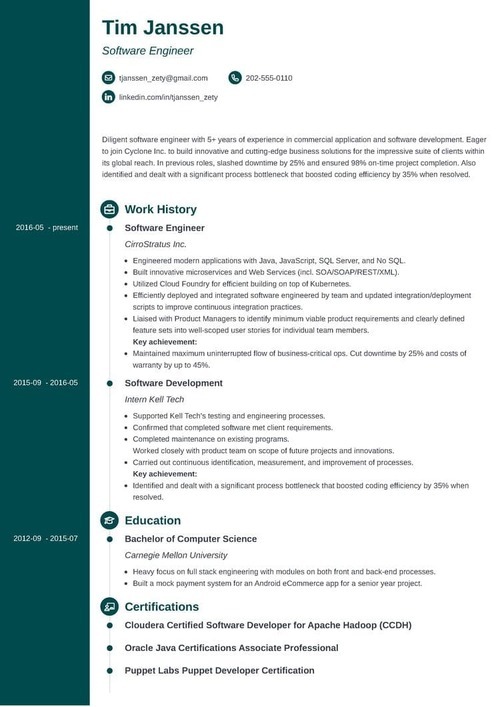
How to Email a Resume to an Employer: 12+ Email Examples
In a sec, we'll discuss how you can email your resume. But first, imagine this:
You find a job offer of your dreams and send your perfect job application via email. Then you wait… and wait. How come you’re not getting the callback?!
The answer? Nobody even saw your resume, as you didn't know how to email a resume correctly. Don’t worry, you’re about to learn everything you need to know about emailing a resume, plus some extra tricks you can use along the way.
In this guide I’m going to show you:
- How to email a resume and a cover letter the right way and get more job offers.
- A resume email sample better than 9 out of 10 resume emails out there.
- How to get in touch with the hiring manager before sending a resume via email.
- The most important rules of resume email etiquette.
Want to save time and have your resume ready in 5 minutes? Try our resume builder. It’s fast and easy to use. Plus, you’ll get ready-made content to add with one click. See 20+ resume templates and create your resume here.
Sample resume made with our builder—See more resume examples here.
Need more tips on writing resumes? Check these:
- How to Create a Resume
- How to Name Your Resume File
- Resume Formats
- Resume Tips
- Resume Examples
- How to Introduce Yourself
- Interview Thank You Email
Also don't forget about the importance of a cover letter:
- How to Write a Letter of Interest
- What Do You Say in a Cover Letter
- How to Start Cover Letter
- How Long is a Cover Letter
- Best Cover Letter Example
1
How to Email a Resume Step By Step
Tired of ending up in the resume Black Hole?
Emailing a resume to a prospective employer instead of applying via job board application forms might just do the trick.
Why?
First of all, it adds a personal touch and shows your persistence.
If done right, the hiring manager will be more enthusiastic about reviewing a job application sent via a personalized email. Trust me, they’re stuck in that Black Hole, too. They’ll be happy to ditch those hundreds of identical job board applications.
Secondly, it boosts your odds of avoiding an Applicant Tracking Software (ATS) resume test.
The sad truth is that many resumes never make it to a human reader. They're weeded out by the ATS. Sending a resume by email, directly to a human being makes it more likely that you’ll receive the attention you deserve.
That said, there’s still a couple of crucial things to keep in mind when emailing a resume. Let’s go through the basics.
Here are 7 steps to successfully emailing a resume.
How to Email a Resume?
- Use an effective subject line
- Address the hiring manager by name
- In the first paragraph, tell the hiring manager who you are and why are you contacting them
- In the second paragraph say what value you’d bring to the company
- Close the resume email body with saying you’re eager to meet in person
- Add a professional signature with your contact details
- Attach your resume and a cover letter saved in PDF with professional file names
Before I show you how it works in practice, I want to introduce you to someone.
Meet Jason. He’s a successful Web Developer. He wants to join XYZ Corp. as an IT Manager. And the email he sent to XYZ’s hiring manager will get him there.
Let’s have a look at Jason’s email resume example:
Sample email for job application with resume
(1) Subject line: Prolific Senior Web Developer Seeks IT Manager Position with XYZ
(2) Dear [Hiring Manager’s Name],
(3) I have attached my resume and a cover letter for the IT Manager position at XYZ.
(4) As the winner of the 2015 Webby Award for Best Navigation and Structure, with a proven record of increasing user experience scores by over 40% on 25+ websites and online apps, my goal is to leverage 10 years of experience to help XYZ succeed with optimizing the UX on your three key online platforms.
(5) I am looking forward to meeting you in person to share my insights and ideas on making XYZ’s web development quicker and more effective.
Sincerely,
(6) Jason McMillan
Senior Web Developer
linkedin.com/in/jason-s-mcmillan
555-555-5555
(7) Attachments:
Jason-McMillan-Resume-XYZ.pdf
Jason-McMillan-Cover-Letter-XYZ.pdf
Now, that’s one hell of a resume email. He’s sure to get a call from the hiring manager.
Pro Tip: If you’d like to email your resume directly to the hiring manager but you don’t know how to get in touch with them, read on. We’ll cover that in-depth.
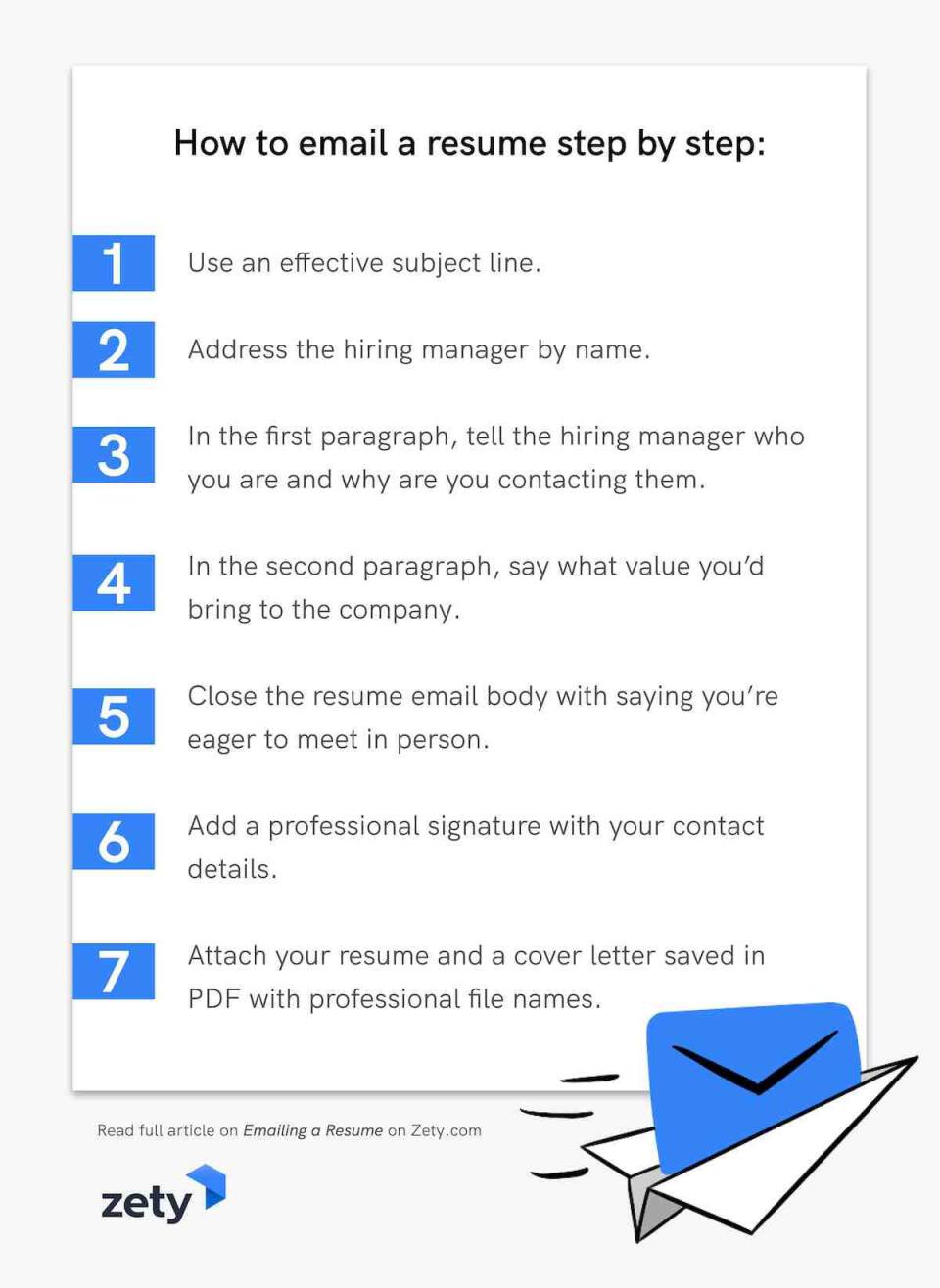
So, now that you’ve seen what to write in an email when sending a resume and a cover letter, let’s see what exactly makes this resume email so great.
Still thinking about that ATS nightmare? Check out ATS-Friendly Resume Templates
2
The Subject Line Is Not as Basic as It Seems
What if I told you that hiring managers test candidates before reviewing their resumes?
The way you submit your application documents also matters. Sure, you can upload your resume and cover letter through a generic online application form. You’ll just end up in the same folder as the other 250 candidates.
Or, you can send a personalized resume email and be in pole position right away!
That is, only if your email gets opened. And guess what?
It depends solely on your subject line. So make the most of it.
State that you’re applying for a job, include the name of the position, job identifier (if applicable), and add some personal branding. Like this:
Resume email sample subject line:
How Do You Start an Email For a Job
| right |
|---|
Subject: Award-winning HR specialist seeks Employer Branding Manager position #12345 |
The hiring manager just rescheduled her meeting to review this application.
| wrong |
|---|
Subject: Resume and cover letter for your consideration |
This one looks like a generic email spammed out to every company within 100 miles.
Pro Tip: If the job offer asks for applying via email, check if the employer demands all applicants to use the same subject line, for instance, “Application for Position XYZ - [Your Name].” If so - you have to play by their rules.
When to send a resume email?
On Mondays, between 6am and 10am.
Research has shown that applying on Mondays boosts your interview rate by 46% compared to the average. Submitting your resume between 6am and 10am (when almost nobody else does it) brings about a staggering 89% rise in hireability!
At the same time, keep in mind the golden rule: first come, first served. It's best to apply within 4 days since the job posting went live. So if you come across an interesting job offer on Thursday, email your resume right away, don't put it off until the following Monday. You'll maximize your chances of getting a job offer email fast.
One more tip, always remember to make your whole job application relevant and specific to the job you’re trying to land. This is called tailoring. It’s the most effective strategy for job seeking: 6 Tips on How to Tailor Your Resume to a Job Description (Examples)
3
What Everybody Ought to Know About a Resume Email Template
Most job seekers make a common mistake:
They think that their email body for sending a resume should read exactly the same as their cover letter.
It shouldn’t.
Why?
Recruiters and hiring managers don’t have the time to review cover letters in their entirety. Your resume email has to be short and sweet. Just enough to make the hiring manager go, “Aaah, interesting!”
In your resume email body, write only about the most relevant things. Make it a sneak peek of your job application. Make it irresistible.
Remember how our candidate, Jason, did it? You can use his resume email as a template:
What to write in an email when sending a resume and a cover letter?
Sample email for a job application with resume - email body:
Dear [Hiring Manager’s Name],
I have attached my resume and a cover letter for [the name of the position].
As a [your major success], with a proven record of [your measurable, quantified, relevant achievements], my goal is to leverage my skills and knowledge to help [the name of the employer] succeed with [the employer’s specific plans].
I am looking forward to meeting you in person to share my insights and ideas on [how you’re going to help the prospective employer with their goals].
Sincerely,
[Your name]
[Your job title]
[LinkedIn profile]
[email address]
[phone number]
That’ll do it. When sending a resume via email, you can’t afford to elaborate on everything. Make your resume email concise and skimmable.
Use the same mail format for sending a resume with a reference. Just remember to mention the name of your reference in the first paragraph.
Pro Tip: If the job ad explicitly asks for a “cover email,” a “covering email,” or an “email cover letter,” these are the only instances where you actually should paste your cover letter into your resume email. You can still attach your cover letter in a separate file, just make sure it matches the content of your cover email.
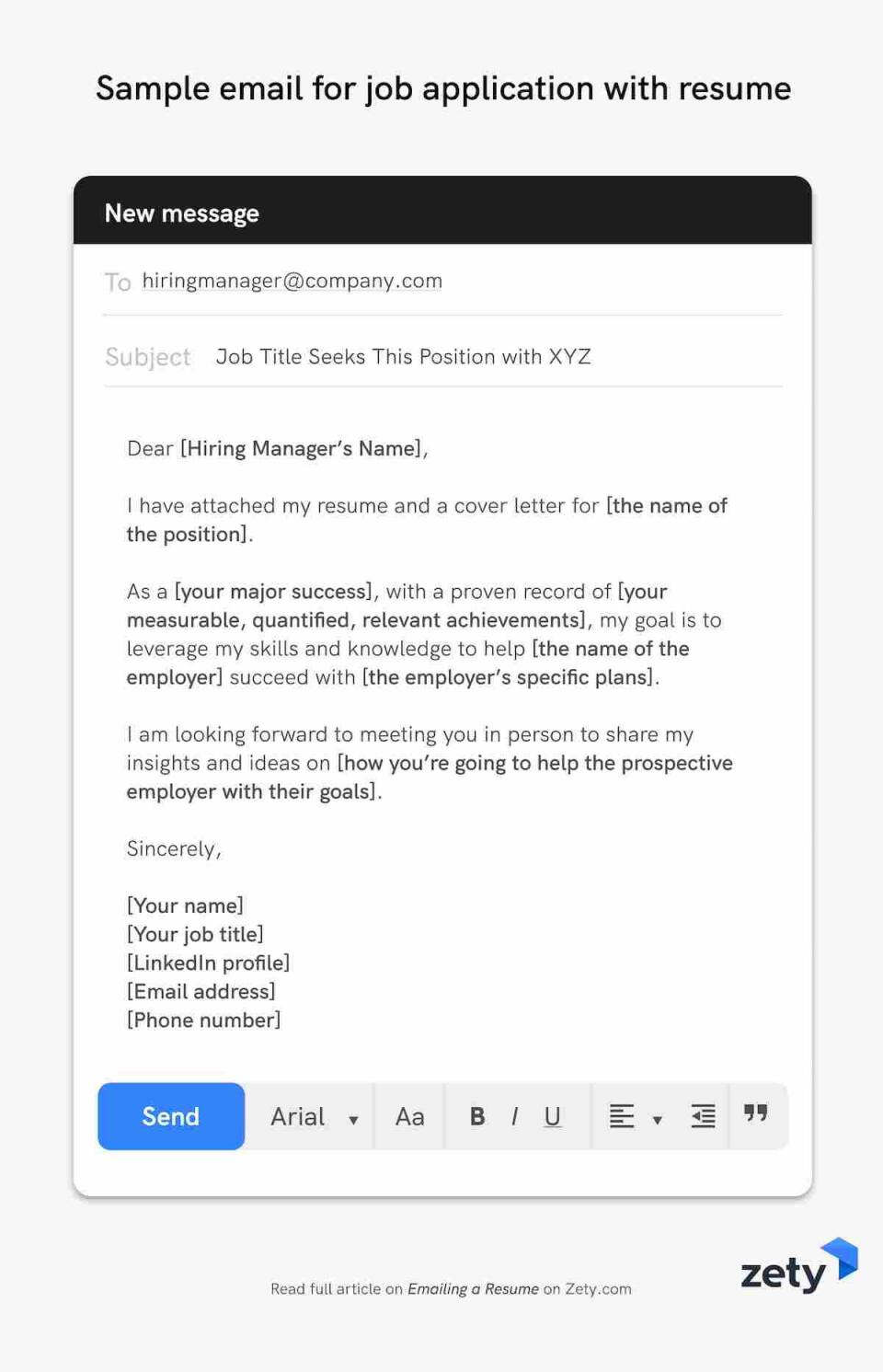
Even if you craft the perfect email to send a resume, you still need a killer cover letter. Luckily, we’ve got a comprehensive, dedicated guide to show you how to write the best cover letter out there. Give it a read: How to Write a Cover Letter for a Job?
When making a resume in our builder, drag & drop bullet points, skills, and auto-fill the boring stuff. Spell check? Check. Start building a professional resume template here for free.
When you’re done, Zety’s resume builder will score your resume and tell you exactly how to make it better.
4
Almost No One Makes a Personal Connection But It Works So Well
Online job offers don’t always reveal who’s going to read your resume. That’s a shame because you are much more likely to get hired if the hiring manager knows of you beforehand.
So, how do you get in touch with a hiring manager?
Well, you might have heard about the six degrees of separation:
You’re only separated from the likes of Kevin Bacon, The Queen of England, and Bill Gates by six other people.
That’s why networking is important. You may not know the hiring manager, but you probably know someone who does.
So, what you’re going to do?
Reach out to friends, alumni, and former colleagues to see if they can put you in touch with the right person.
Okay, but what if you’ve actually never networked and have few professional connections?
Do some research to find the internal recruiters or HR personnel responsible for processing resumes where you want to work.
Start with the company’s website to find the name of the hiring manager. Then, move to LinkedIn to see if you can find their email address.
While finding a name is easy, finding an email address can be harder. Start by using an app called findthat.email.
Once you've found a promising LinkedIn profile, the app will generate an email address for you.
If that doesn't work, you can try the oldschool way and use Google.
Start your search with the company’s email domain:
*@company.com
The search may not lead you directly to the hiring manager’s personal email address, but it’ll show you what formula the company uses for all of its email addresses.
See, most companies use the same formula:
[email protected]
[email protected]
If you can find that formula, all you need to do is plug in the hiring manager’s name.
Can’t find the address formula either? You’ve only got the names of the company and the hiring manager?
Good news!
You’ve still got enough information. Here’s an Email Permutator that automatically generates all possible combinations of the hiring manager’s name and the company’s domain.
Run them through a free email verification tool like MailTester. It isn’t flawless, but it’s a good way to lower your bounce rate.
Pro Tip: If you've always wanted to work somewhere, don't wait for open positions or linger on job boards. Reach out by emailing a resume. Position yourself now so you'll be in the right place later.
Note, not all hiring managers will appreciate receiving unsolicited resumes.
Which is why you will want to start the process by sending the hiring manager an invite via LinkedIn.
Why?
By making a connection on LinkedIn first, the hiring manager gets a heads up. Otherwise, emailing a resume may come across as unprofessional or even as spam.
Julie Dossett, Communications Lead at LinkedIn Canada, says:

And never send out email of this kind without first learning who you should be addressing it to. Using To Whom It May Concern looks lazy. Dear Hiring Manager? A bit better. But since you'll be contacting people out of the blue, do give them the courtesy of learning their name.
Plus, a great cover letter that matches your resume will give you an advantage over other candidates. You can write it in our cover letter builder here. Here's what it may look like:
See more cover letter templates and start writing.
Key Takeaway
Writing a good resume email for a job application is a very effective strategy few job seekers use. Now you know how to do it right. Just remember the key strategies we covered.
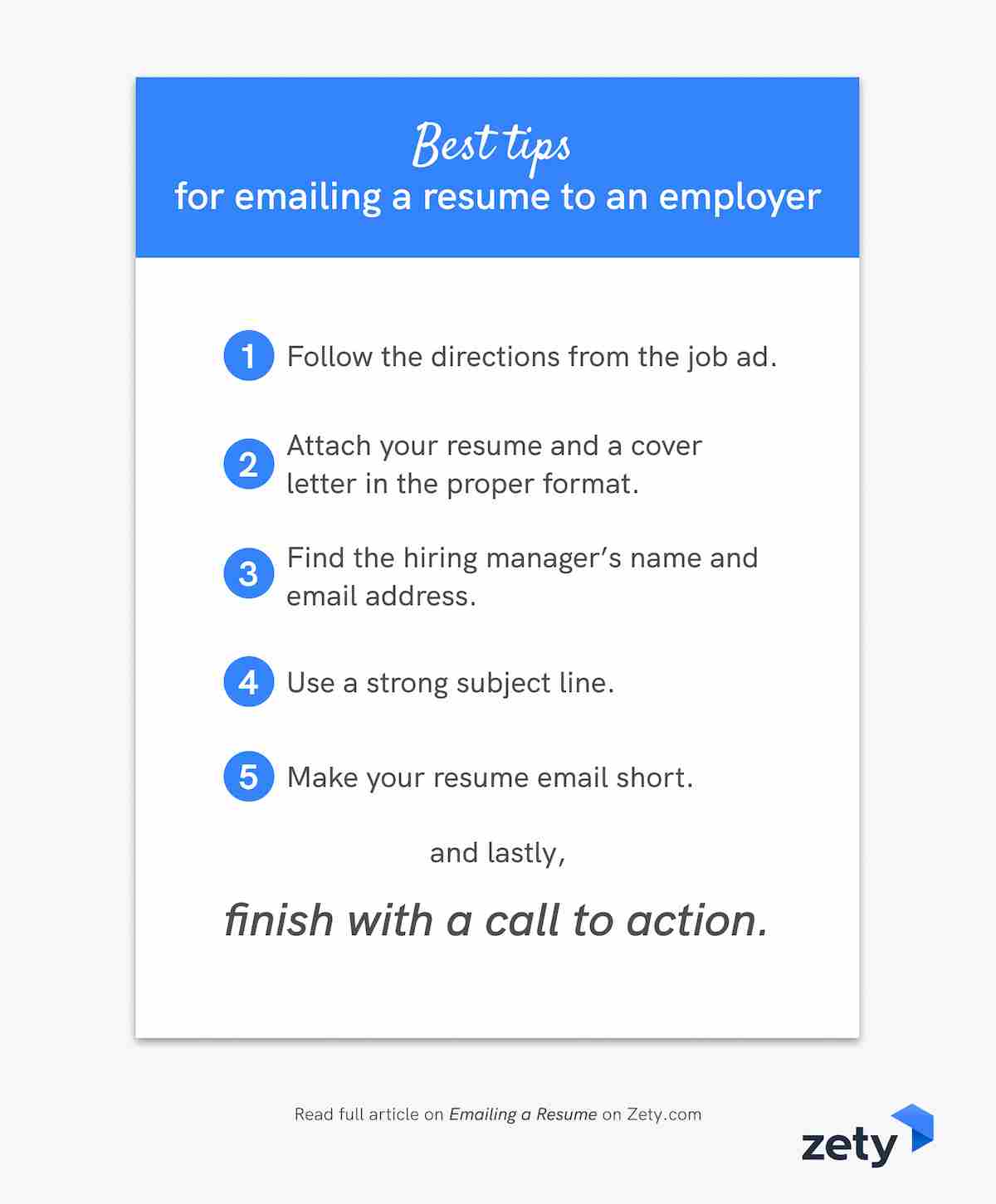
The best tips for emailing a resume to an employer:
- Follow the directions from the job ad. Remember, you have to play by their rules.
- Attach your resume and a cover letter in the proper format. Usually, PDFs work best, but double-check with the job offer: some employers only accept DOC files.
- Find the hiring manager’s name and email address. Send your resume email directly to them.
- Use a strong subject line. Include the name of the position, the offer id, and spice it up with some personal branding.
- Make your resume email short. It’s not your cover letter all over again. Focus only on your most stellar achievements.
- Finish with a call to action. Say that you’re eager to meet in person to discuss how you can contribute to your prospective employer’s success.
Do you have any questions on how to write an email for job applications? Want to learn more about resume email writing? Let us know in the comments!
